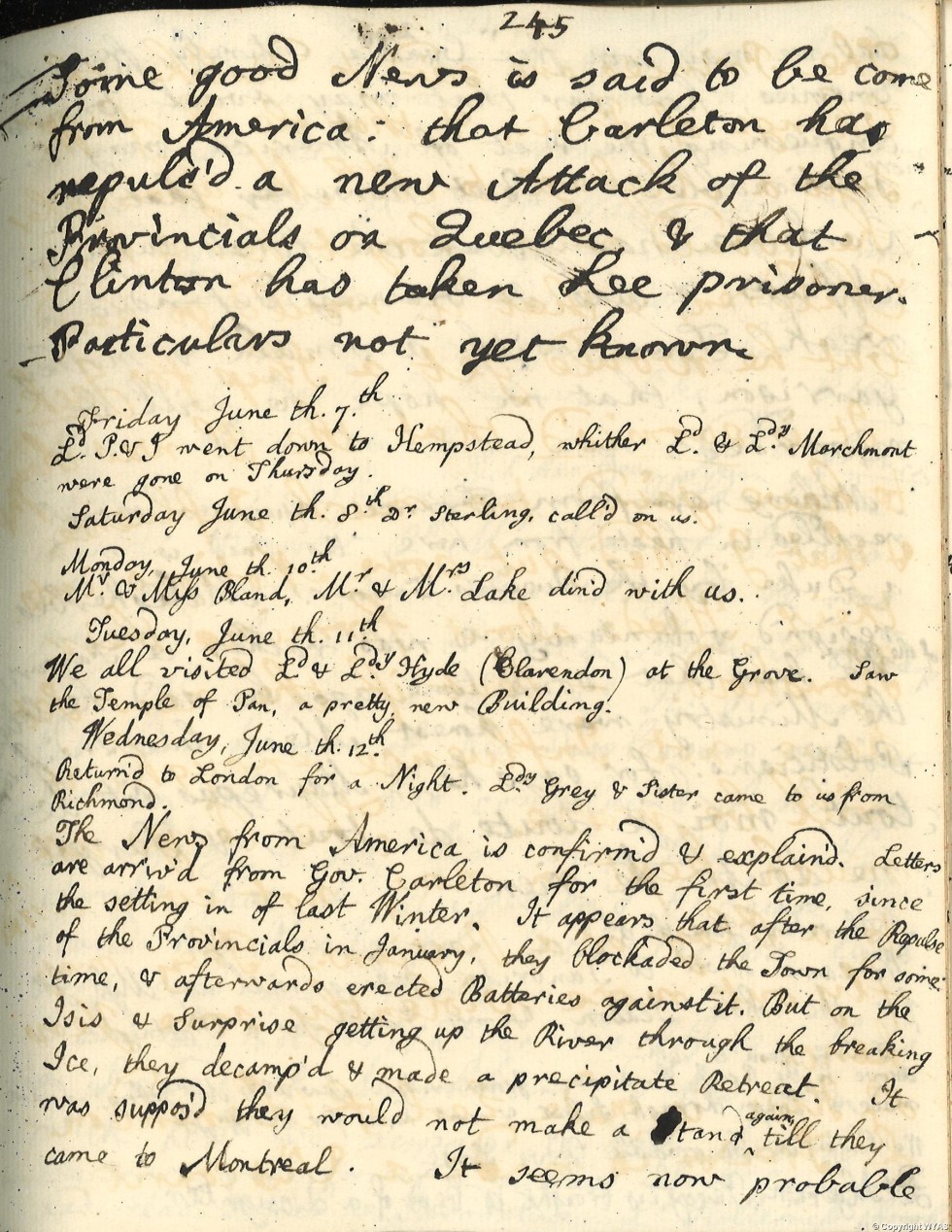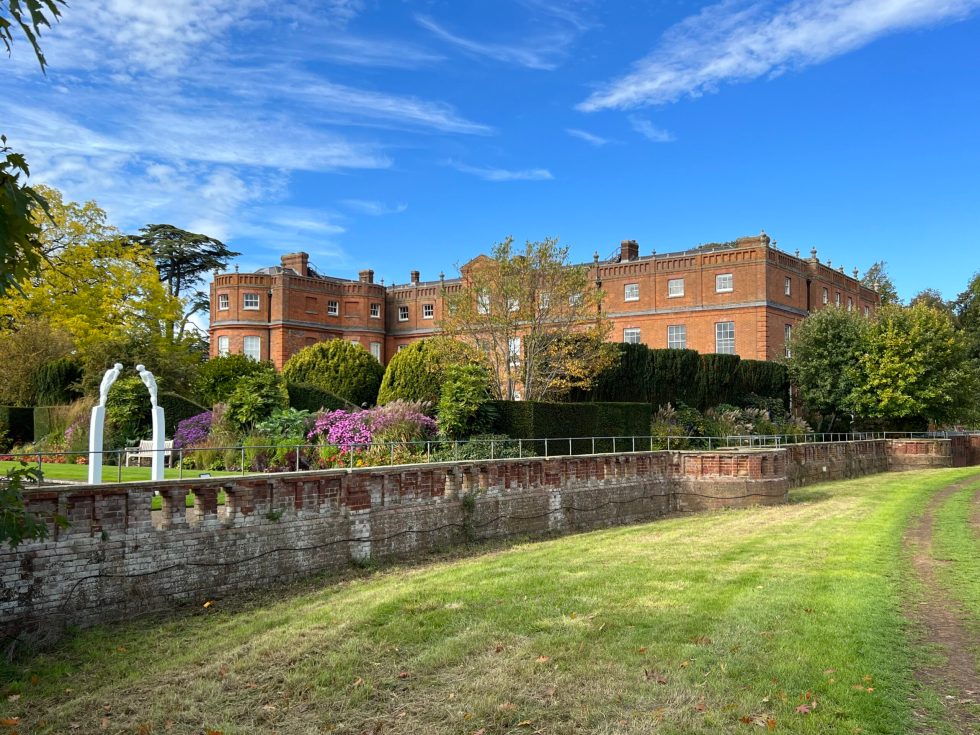Lady Amabel Yorke was the elder daughter of Philip Yorke, 2nd Earl of Hardwicke, and his wife Jemima Campbell, 2nd Marchioness Grey, 4th Baroness Lucas. Their family seats were Wrest Park, Bedfordshire, and Wimpole Hall, Cambridgeshire, both of which had parks that were remodelled by Capability Brown with Amabel being privy to the design decisions. She was, then, rather well-informed on matters of landscape gardening, and her 37 volumes of diaries contain countless accounts of visits to the seats of her friends and family, where she sometimes notes follies and garden ornaments.
Amabel (1751-1833) married Alexander Hume Campbell, Lord Polwarth, in 1772, much to the chagrin of the Dowager Duchess of Gower, who complained to her friend that too many of England’s eligible (for which read rich) brides were being ‘transplanted to Scotland’. After Polwarth’s early death in 1781 Amabel settled in England and, mourning period over, enjoyed a busy social life amongst the upper echelons of society (N.B. through marriage and inheritance she used a number of titles during her life, so for clarity she is simply referred to here as Amabel.)

Where Amabel’s journals are of most value to garden history is when she makes return visits to the same landscape, recording new developments and enabling precise dating, although she seldom gives elaborate descriptions. One such example is The Grove, near Watford in Hertfordshire, the seat of Thomas Villiers (1709-1786), created Lord Hyde in 1756, and his wife Charlotte (1721-1790), a daughter of the Earl of Essex. Lord Hyde bought The Grove in 1753, conveniently next-door to his father-in-law, whose Cassiobury seat was contiguous, and began remodelling the house and grounds. Amabel visited the Villiers family on a number of occasions: first with her family and then with her husband. Her earliest mention of The Grove in her diaries is in 1770, when she writes simply that the grounds were ‘very pleasant’.

In June 1776 Amabel went to The Grove to stay with Lord Hyde (although within days of her visit he would be raised to the peerage as the Earl of Clarendon). On this occasion her hosts took her to see the Temple of Pan, which Amabel records in her diary as a ‘pretty new building’. The Temple has long ago disappeared, but happily a drawing by Thomas Baskerfield survives, and from various accounts we can piece together that it was a brick building with rustic decoration: the drawing suggests that the columns are tree trunks, rather than stone pillars. It was ‘used occasionally by the family of the Earl of Clarendon for tea-drinking’. We know little of the interior other than it contained lead statues of ‘pagan deities’.

This was the most famous of the buildings at the Grove, particularly in the first decade of the 19th century when the 2nd Earl of Clarendon hosted a series of Fête Champêtres in and around the Temple of Pan. Clarendon and his friend the Hon. Mr Capel, son of the Earl of Essex, hosted parties for hundreds of guests. Dinner was served, a band played and guests could dance in the temple or in the glade. There were fireworks, and the earl graciously allowed the ‘peasantry’ to pay a small fee to watch the proceedings ‘from the recesses of the wood’. A contemporary satire of the fête champêtres at The Grove ridicules this largesse, and has the gamekeepers under orders to ‘shoot all Plebeians passing through the park’.

Amabel returned to the The Grove a year later in 1777, and saw two recently completed landscape ornaments: the ‘new building called the Arcadian Mausoleum’, and the ‘Scotch Seat’. Amabel doesn’t elaborate on the former, but other contemporary sources tell that the ‘shady Tomb’ purported to be the burial place of Pan, and was intended to be seen in conjunction with Pan’s temple, which was not far away. Drawings by Baskerfield suggest it was a sham classical ruin, circular in form, with niches in the interior walls for funerary caskets. Above the door was a plaque declaring it to be an ‘Arcadian Mausoleum repair’d’.
The Scotch Seat was a decidedly quirky structure, painted with ‘Highland Arms and Plaids’. We know more about this building because only a few years later, in 1799, a satirical poem was published called The Scotch Hut. Dedicated to ‘The Earl of the Grove’, the anonymous verses mention a number of the garden buildings. The annotations describe the Scotch Hut as a ‘low, wooden Building, covered in Thatch’, with an interior painted with ‘the Insignia of Scotland: Dirk and Broadsword, Pistol and Target, Bonnet and Bagpipes’. It was hung with curtains in tartan fabric, and the exterior was also ‘plaid’, which must have been quite a challenge for the estate’s painters. A later visitor confidently declared it had ‘a good resemblance to the residence of a highlander’, but sadly, no views are known to survive.
At The Grove again in 1782, Amabel revisited the ‘Temple of Pan and the ruin’d Mausoleum’. She also walked to see the ‘new Ionic Building’, a classical temple she had not seen before. This elegant building topped with a dome was called the Ionic Temple, but became known colloquially as the Eggshell.

As well as keeping a diary Amabel also recorded many of the scenes she saw on her travels in sketches and watercolours. She was a talented amateur artist, some of whose works were used on Catherine the Great’s ‘Frog Service’, produced by Wedgwood, but sadly no views of The Grove in her hand have been found.
The Temple of Pan was still in use in the middle of the 19th century, when the children of the family held tea-parties there and had the novelty of cooking their own food. The Eggshell stood until the 1960s, but sadly none of the fanciful structures (there were many others which Amabel didn’t mention) survive today. The Grove became a school in the 1920s, and was then in institutional use for many decades. It is now a rather smart hotel with all the bells and whistles, including a golf course, of which more in a moment.

In 1801, writing in her 20th notebook, Amabel wrote that ‘Volumes follow Volumes & crowd my Drawers with little Use to myself and still less to other People’. She might be surprised to find how important her diaries have proved to be: over 200 years later, social and garden historians can find much fascinating detail in the diaries, which are now available to all thanks to an excellent ongoing project by the West Yorkshire Archives Service.

The pleasure grounds at The Grove are now home to a golf course. The Folly Flâneuse is not a golfer, but were she ever tempted her first stop would be The Grove, for each of the 18 holes is named after a landscape feature that once adorned the grounds: what fun to tee-off at the Scotch Hut, Temple of Pan, Eggshell or Mausoleum.

You can find out more about the hotel here https://www.thegrove.co.uk
Amabel’s diaries have all been digitised and are now online. A number have been transcribed so that they are fully searchable by keyword, and this work will continue when funding allows. Thanks to Vicky Grindrod and Harriet Harmer of the West Yorkshire Archive Service (Leeds) for their help with this post. This link will take you to the catalogue to start exploring https://www.catalogue.wyjs.org.uk/CalmView/TreeBrowse.aspx?src=CalmView.Catalog&field=RefNo&key=LC00997%2f7%2f6%2f9%2f90
Thank you for reading. Please scroll down to the comments section at the foot of the page if you would like to share any thoughts.






Jane Padfield says:
Fascinating story. I followed the link to West Yorkshire Archives and found that Amabel’s diaries were found with Viner family papers at Fountains Hall. Is it you known how they came to be there, as Amabel doesn’t seem to have had any Yorkshire links?
Editor says:
Hello Jane. I believe the diaries passed down through her sister’s sons (Jemima, seen with her in the portrait). Jemima married Lord Grantham of Newby Hall and her sons and grandsons became Earls and then Marquesses of Ripon of Studley.
Garance says:
How lovely that you have been able to use Amabel’s diaries to weave these wonderful stories and follies together. Yet another good Saturday read – thank you!
Editor says:
Thank you Garance. I have been dipping into Amabel’s diaries for many years now. They are a wonderful resource and I wanted to share the great news that they are being made available to a much wider audience. Glad you enjoyed it.
BRIAN WARD says:
This takes me back to the 1960s when I was a management trainee with British Railways. The Grove was at that time a Work Study school and I spent time there learning the dark arts of work study, a subject much to the fore in industry in those days.
Editor says:
Good afternoon Brian. I read that it had been a BR property. I hope you enjoyed working in such lovely surroundings. Did you ever have the opportunity to explore the grounds? Thanks for getting in touch.
BRIAN WARD says:
I’m sure we must have wandered through the grounds in spare time, but nowadays I can’t recall any details of it I’m afraid. It certainly would not have been anything like a 5* hotel!!! Spartan accommodation, more likely.
Editor says:
It is rather smart nowadays! I doubt there was much left at all when you were there, sadly.
Colin says:
Thanks – wonderfully written and a very enjoyable and informative read!
Ashley says:
I agree! Thank you for these articles.
Editor says:
And thank you too, Ashley.
Editor says:
Thank you Colin. I really appreciate you taking the time to let me know.
Barbara Howard says:
I’ve always wondered how that name is pronounced. A Mabel or Amabel to rhyme with Annabel.
Editor says:
Morning Barbara. I’ve always pronounced it in the same way as ‘Annabel’, but I am happy to be corrected if anyone knows differently.
Mrs Barbara Howard says:
Thanks!
Hazelle Jackson says:
Fascinating stuff, as always. Hazelle.
Editor says:
Hello Hazelle. I’m pleased to hear you enjoy the posts, and I appreciate you taking the time to let me know.
Tony Cleaver says:
A fabulous read, as ever. Thank you so much. Tony
Editor says:
Good morning Tony and many thanks for your comment, which I was delighted to receive.
Alan Knight says:
We are very fortunate to have access to such rich material on line, thank you.
The Grove and the Eggshell temple were part of our playground during the 1939 -45 War and the years following when the whole house and grounds were near derelict. It seemed to us a no-mans land of wonders especially the Round Temple which was incomprehensible to us, and the entrance lodges, and the Gate houses to Lady Capel’s Wharf.
Editor says:
Good evening Alan and thanks for taking the time to share your memories. The Grove today is a rather different place of Ferraris rather than follies, and it is very far from derelict. I can imagine how the abandoned site exercised your imagination as a child.